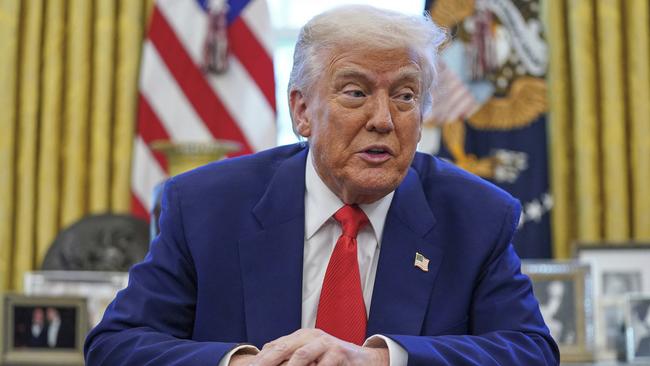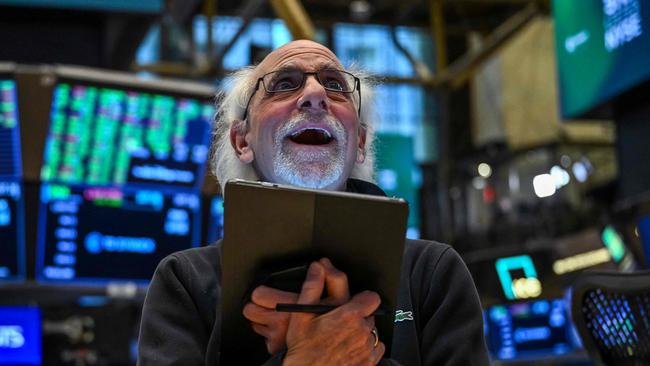How the bond market scared Trump into action
The US President blinked as a violent sell-off of US treasuries sounded the alarm for a full-blown financial crisis.

Donald Trump’s trade war staring contest ended with a whimper on Wednesday as the US President blinked in the face of a violent sell-off of US treasuries and the prospect of a full-blown financial crisis.
Equity markets surged as Trump announced all countries bar China would get a 90-day reprieve from the reciprocal tariffs investors had feared would trigger a global recession.
The S&P 500 climbed 9.5 per cent, the Dow finished up 8 per cent and the Nasdaq climbed 12 per cent in its best day since 2001. Locally, the S&P/ASX 200 rose 4.6 per cent.
It was not the four-day Wall Street sell-off which forced the US President’s hand but chaos and dysfunction in the bond market.
The US benchmark 10-year bond rate, which a week ago fell below 4 per cent, lurched and climbed as high as 4.5 per cent on Wednesday, moving further away from the President’s target and signalling a loss of confidence in the US. Investors typically seek refuge in treasuries in times of financial strife. As demand drops, so do prices, leading to surging yields.
The sell-off was triggered by global investors, including Japan and China, losing faith in the US and exiting out of bonds. This was compounded by hedge funds unwinding the so-called ‘basis trade’ — the trading strategy which arbitrages the spread between treasuries and futures using borrowed leverage.
By some estimates this basis trade now stands at $1 trillion, nearly double what it was in the run-up to the Covid crisis.

“When treasuries stop acting like treasuries, everything breaks. That’s when even the most tariff-hardline White House realises it is time to pump the brakes or risk a full-blown funding crisis,” SPI managing Partner Stephen Innes said, as he warned of the risks ahead.
“There’s still a considerable amount of (risk) with that 90-day fuse ticking down. But for now, it feels like we’ve hit reset … returning to the original mission: to level the playing field, not to scorch the system,” he said.
Explaining the move to pause the reciprocal tariffs, President Trump pointed to the bond market action.
“The bond market is very tricky … people were getting a little queasy,” Trump said on Wednesday.
“I thought that people were jumping a little bit out of line. They were getting yippy, you know, they were getting a little bit yippy, a little bit afraid,” he said of the decision to pause tariffs.
The delay has injected some much-needed calm into the market but it will extend the uncertainty for businesses and investors, market watchers warned.
“The 10-year (US bond) is back down to 4.34 per cent, but it’s still higher than it was (before Liberation Day),” AMP chief economist Shane Oliver said, as he warned a US recession was still on the cards.
“The problem is Trump has already done a lot of damage to confidence in the US and that’s going to be hard to recover. There could still be a recession. All he’s done is change the start date on the tariffs,” Dr Oliver said.
AMP estimates the outsized 125 per cent tariff slapped on China will offset the impact of the reciprocal tariff delay.
“Thirteen per cent of imports in the US come from China. Trump has chopped the tariffs back to 10 per cent for everybody but pushed China to 125 per cent. When you do the maths on that, you still end up with an average tariff going to the US of about 28 per cent across all countries,” he said.
“On one hand, the market is relieved to see that Trump has blinked, that he’s responded to pressure from financial markets. On the other hand, investors are still going to be pretty nervous because the average tariff going to the US is still around or above what was announced last Thursday, just the mix is different. And there’s 90 days to go.”
SPI’s Innes also pointed to the challenges ahead for the US economy.
“Those 100 per cent-plus China tariffs are still locked in. That’s not a sideshow — that’s structural inflation risk and a slow leak on growth. The US consumer might not feel it right now, but that pain’s in the pipeline, especially with limited substitutes for some of that import flow,” he warned.






To join the conversation, please log in. Don't have an account? Register
Join the conversation, you are commenting as Logout